-
January 27, 2020 by Total Fire and Safety

How important is the fire code for animal shelters? Deadly fires at kennels and animal shelters are not uncommon across the U.S. In the past year, over 100 dogs have died in kennel fires, including here near Chicago.
On the night of January 14, 2019, a West Chicago animal kennel went up in flames. Thirty-one dogs perished in the fire. The exact cause of the fire is unknown, but investigators determined no staff was present at the time and no working fire sprinklers were on property. The kennel did have fire detectors, but no one was around to hear them.
The tragedy prompted lawmakers to come up with legislation to ensure such an event never happens again. The new law, signed in August, went into effect January 1. The legislation requires kennels to be staffed 24/7 or have sprinkler systems or alarms that alert local fire departments.
When it comes to arming animal shelters with lifesaving equipment, Total Fire and Safety can help with the installation of …..
Wireless Fire Alarms
- Preferred by fire departments, they are more reliable than land-based systems for their quick and accurate response.
- They can save phone line costs.
- They reduce false alarms to fire departments
- Minimal and guaranteed wireless radio alarm monitoring fees
Fire Sprinkler Systems
- A working fire sprinkler is 96% effective in containing a fire.
- Monthly, quarterly, and annual inspections are necessary to ensure safety and keep your building fire code compliant.
- TFS uses the most up-to-date technology and thorough process to prevent sprinkler failure.
Working fire extinguishers can keep a small fire from getting out of control when someone is in the facility. Every business needs working fire extinguishers at the ready, and be trained to use them.
- A fire extinguisher is your first line of defense, 24/7.
- 30% of fire extinguishers are not in working order. We complete a 12-point inspection to make sure they are fire ready.
- On-site training is provided to guarantee proper employee usage.
All it takes is basic fire protection to save animal and human lives.
Illinois’ new fire code will help protect our furry friends from another senseless tragedy and prevent irreparable damage to lives, structures, and pocketbooks. Total Fire and Safety can equip your facility with the latest fire protection and help maintain the equipment installed. Give us a call today at (630) 960-5060.
Category: Business Safety, Fire Alarm Monitoring, Fire Extinguishers, Fire Extinguishers, Fire News, Fire Safety, Sprinkler Systems, Total Fire and Safety Tags: commercial fire safety, commercialfiresprinkler, employee training, fire and safety equipment, fire and safety solutions, fire safety in the news, Firesprinkler, Total Fire and Safety, wireless fire alarm monitoring, wireless fire alarms, wireless fire alarms for business | Comments Off on A New Fire Code for Animal Shelters in Illinois!
-
September 25, 2019 by Total Fire and Safety

If you have ever visited a historic building, what do you notice? Old documents, precious artwork, impeccable craftmanship, and… fire protection equipment? Hopefully your answer to the latter is no. Ideally, historic properties should still maintain the look and feel of an era gone by, but how do you do it and still install and maintain fire equipment that’s up to code?
Everyday commercial buildings are damaged by fires, causing a huge loss for any business. However, these damages can be repaired, sometimes improving the building from its previous structure. This is not the case for historic properties. The true extent of the loss is more significant than the cost of simply restoring the building. Any artifacts, documents, etc. that are lost represent a priceless piece of our heritage.
For the fire safety expert, the challenge of fire protection in a historic building presents three distinctive challenges:
Preserving the Historic Character
In order to protect historic buildings, sometimes structural engineers, preservation specialists and the building managers must get involved in addition to the fire protection experts (TFS). Together they design a solution that meets the needs of NFPA compliance without ruining the historic character of a building. For example, a historic door cannot be replaced with a fire-proof door, however installing sprinklers on either side of the door may be the answer.
Fire safety is prioritized even with our most beloved historic institutions. For example, currently there is a major renovation going on at Mount Vernon, the home of our first president, George Washington. Part of this extensive construction is major improvements to the fire suppression system. When all is said and done, fire safety for Mount Vernon and its visitors will be vastly improved for generations to come.
Total Fire & Safety’s client roster includes many historic buildings, especially in the Village of Downers Grove. We are proud to be able to keep visitors safe while maintaining the distinctive character of each building.
Staying Out of Sight
Ideally, fire protection systems must sufficiently protect a building but remain aesthetically pleasing. One common cause of concern is the fire sprinkler system. Not only do fire sprinklers damage a building’s contents, but they can deface the historic structure. The answer lies in coming up with creative solutions for fire sprinklers:
1. Use copper tubing vs. black or steel pipe to blend in with the building’s architecture.
2. Faux materials can be used that resemble the buildings time period to conceal fire sprinkler pipes.
3. Install painted fire sprinkler heads to match the area.
Another form of hidden fire protection commonly used in historic buildings is wireless fire alarms. Wireless alarms are an ideal, minimally invasive solution when needing to preserve the look and feel of a building. Other advantages to wireless fire alarms include:
- Wireless alarm monitoring provides faster response
- No cables are required for installation
- They eliminate false alarms, which can be costly for non-profit buildings
Updating Outdated Utilities
Many historic facilities have poor water pressure. This renders a fire sprinkler upgrade useless unless an underground line, additional line, or fire pump is installed. Total Fire & Safety can be helpful in making the right decision for any historic property.
Regardless of the fire protection systems installed, working to minimize the ignition of a fire should be a priority. Scheduling fire safety inspections annually is important to maintain a safe environment for the building and its occupants. Total Fire and Safety works not only to uphold the integrity of an historic building, but also provides the best fire protection equipment around. Give us a call today! 630-960-5060
Category: Business Safety, Fire Equipment Inspections, Fire exits, Sprinkler Systems, Total Fire and Safety Tags: commercial fire protection, commercial fire safety, commercialfiresprinkler, fire and safety equipment, fire and safety needs, fire and safety solutions, Firesprinkler, firesprinklerinspections, Total Fire and Safety, wireless fire alarm monitoring, wireless fire alarms, wireless fire alarms for business | Comments Off on Preserving Fire Safety in Historic Buildings
-
August 31, 2019 by Total Fire and Safety

Once again active shooting in public places is making headlines and making us consider our self defense options wherever we go. Unfortunately, our safety can be threatened almost anywhere, and self-defense is important. In your workplace or the facilities you manage, it’s important for the people inside to know how to react in the event of an active shooter or other attack.
In the case of an active shooter or other violent attack, potential victims have little or no advance warning. The sound of gunshots may be the earliest alert you receive, leaving little time to react. That’s why it is more important that you are prepared with a proactive plan of self defense, so you know how to respond immediately.
For years we were taught to shelter in place and wait for first responders. But studies have found that this line of defense results in increased casualties. Recently, offices and buildings have adopted the ALICE response plan. ALICE is an acronym for the five steps you can take to survive an active shooter attack. You may or may not use all the steps in the plan, but it’s nice to know that the fire extinguishers we regularly install and service, can actually be used effectively against an attacker in the “C” or “counter” step of ALICE.
So, in the event of an attack, remember ALICE:
- Alert- Let everyone in the office or the building know what is going on when you hear gunshots, receive a warning or phone message, etc. The faster you communicate, the more lives can be saved.
- Lockdown- If evacuation is not an option, lock the door, barricade it, and cover windows. Look for alternate escape routes, call 911, but do not open the door. Prepare yourself for the shooter to enter.
- Inform- Pass on as much information as you can. Who, what, where, when! The more those around you know, the better.
- Counter- Counter is one of the most dangerous but potential life saving strategies within the ALICE response. To counter is to fight back. Even in schools, there is one weapon, available to all, allowed and required in all buildings, and easy to use at your disposal against a predator. It’s your FIRE EXTINGUISHER!
While any object can become a weapon against the shooter, that five or ten-pound fire extinguisher on the wall can be very powerful. Remember that an armed assailant will not have a free hand to block counterattacks, nor will they be expecting one. Use your fire extinguisher to throw at the shooter or as a bludgeon when he comes through the door. Even if hitting him over the head does not knock him unconscious, it can buy you time to escape. You can also pull the pin and deploy the contents which can potentially blind or suffocate the shooter, or at the very least, startle him/her, long enough to disarm or tackle them.
To use a fire extinguisher, remember PASS:
- Pull the pin. Hold the extinguisher with the nozzle pointing away from you and release the locking mechanism.
- Aim low. Point the extinguisher at the base of the fire.
- Squeeze the lever slowly and evenly.
- Sweep the nozzle from side-to-side.
Once the can is empty, keep your grasp and ram the bottom of the can into the attacker’s face or body. Having training on how to correctly use a fire extinguisher ahead of time can ensure that your employees are prepared for more than fighting fires!
If you automatically locate the nearest escape doors when you go into a public place, it’s also a good time to note where the fire extinguishers are located, just in case.
The last letter in the ALICE acronym is “E.”
- Evacuate- Escaping the danger zone is always the best self defense option in the event of a shooter. Total Fire & Safety offers emergency evacuation and fire safety training so your people are trained to respond in a productive, organized way should an emergency ensue.
Total Fire and Safety is committed to all areas of life safety, including self defense against active shooters. For more information on our training, see our website or give us a call: 630-960-5060.
Category: Business Safety, Fire Extinguishers, Fire Extinguishers, Fire Safety, Health and Safety Tags: employee training, fire and safety equipment, Fire Extinguisher, fireextinguisher, Fireextinguishertraining, firesafetytraining, lifesafety, safety, Self Defense, Total Fire and Safety | Comments Off on When Self Defense Meets Fire Safety
-
July 23, 2019 by Total Fire and Safety
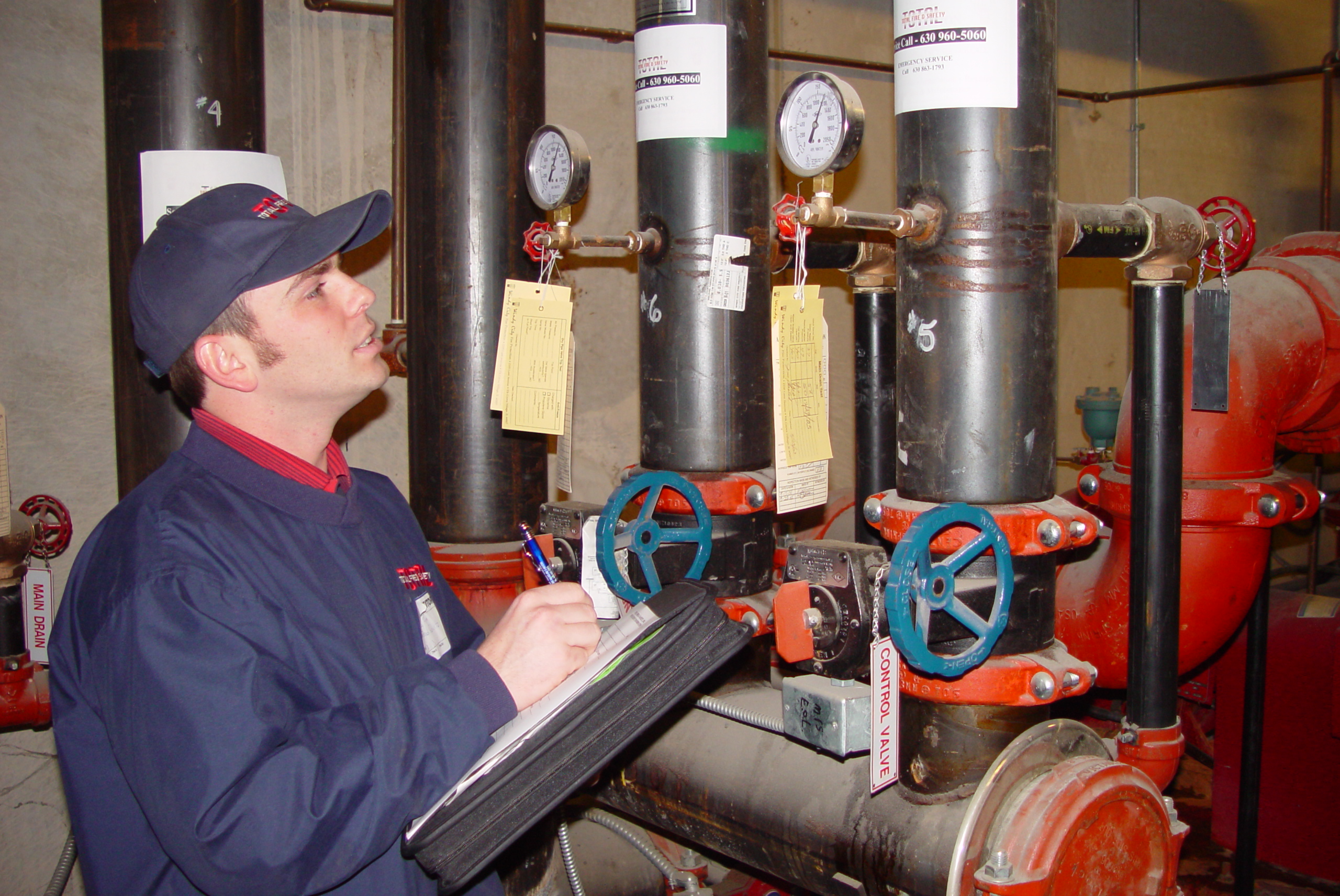
When people think of careers in fire safety in Illinois, they usually think of firefighters. But what about the folks who prevent the fires in the first place? These dedicated professionals work in the area of commercial fire safety. They help commercial buildings and residential dwellings stay up to code with the fire safety equipment, and thus, can save lives indirectly by keeping people safe and prepared for fire emergencies.
Providing fire safety to any business, at any level, starts with teamwork. If one aspect of fire safety fails (sprinkler, extinguisher, or alarm), it can make the difference between life and death. All the fire safety components work within a life safety ecosystem, which includes government code compliance, a skilled workforce, and an investment in safety equipment, installation, and training. As part of a commercial fire safety team such as Total Fire and Safety, you are part of a life-saving mission. We provide customers their first offense in putting out a fire on their premises.
According to the Bureau of Labor Statistics and their Occupational Outlook Handbook, the projected employment change for security and fire alarm system installers is expected to grow 14 percent, which is faster than the average career. They are expecting growth of 10,400 new jobs between 2016-2020. Currently, Illinois, the home state of Total Fire & Safety, is among the states in the nation that employs the most installers in this field. (see chart below).
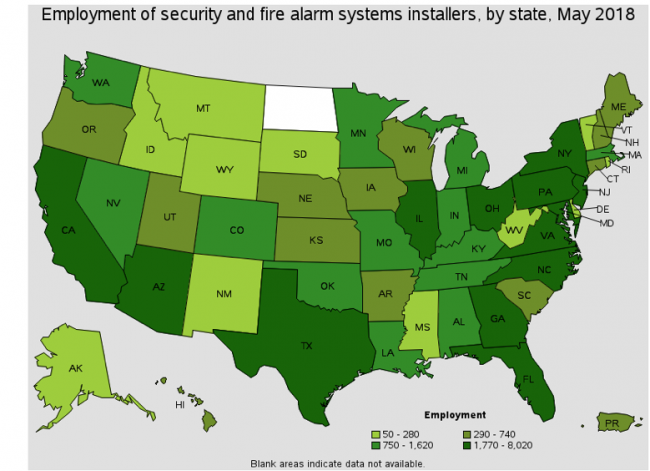 Chart reprinted from Bureau of Labor Statistics, Occupational Employment and Wages, May 2018, 49-2098 Security and Fire Alarm Systems Installers
Many of the careers in fire safety require a high school diploma or equivalent but mainly, on-the-job training. At Total Fire & Safety, we have a vigorous employee training program that prepares our people for many of the jobs that are so needed in the industry, such as customer service, sales representatives, dispatchers, fire alarm service technicians, fire extinguisher technicians, fire sprinkler service technicians, etc. We even have an on-site training facility (pictured below) where we regularly host classes and training modules for TFS employees.
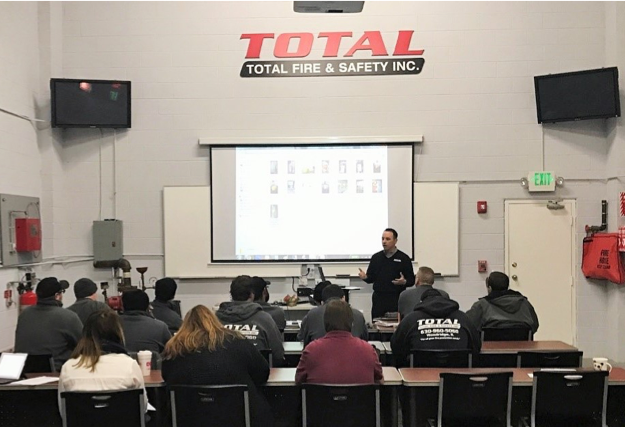
You’ve heard the phrase teamwork makes the dream work, right? At Total Fire and Safety we are always looking for dedicated professionals to join our commercial fire safety team, which has that has provided fire safety for over 30 years. If you are looking for employment or are ready for a career change, join Total Fire and Safety and see how working as a team can save lives.
To learn more about the opportunities available and experience needed at Total Fire and Safety, visit our employment page or search us on Indeed.
Category: Business Safety, Fire Safety, Total Fire and Safety Tags: commercial fire protection, commercial fire safety, employee training, fire and safety equipment, fire safety, fire safety training, Fireextinguishertraining, firesafetytraining, Total Fire and Safety, training | Comments Off on Find Your Career in Illinois Commercial Fire Safety
-
May 20, 2019 by Total Fire and Safety

(Photo credit: Dreamstime ID 95654936 © Wavebreakmedia Ltd | Dreamstime.com)
With the rise in popularity and construction of senior living centers, fire safety continues to be a concern to keep our grandparents, parents, and aging loved ones protected. According to the United States Fire Administration, in 2015, older adults represented 15 percent of the U.S. population and suffered 40 percent of all fire related deaths. They are also 2.7 times greater risk of dying in a fire than the total population. Those 85 and older were 3.8 times more likely to die in a fire than the total population.
The elderly in multi-level dwellings are at higher risk of dying in a fire for several reasons. They may be on medication that impairs them from taking stairs down to safety, or their mobility issues may prevent them from moving quickly enough. They may live alone or have no one to call for assistance. Educating property managers, caretakers, and the elderly on fire safety for senior citizens is one step we can take in protecting this aging generation. Below are some considerations for property managers and their tenants.
1. Test Smoke Alarms
Smoke is a silent killer. Senior citizens with hearing problems who sleep without a hearing aid could be killed in their sleep. Having a working smoke alarm in every room and hallway helps, but they should be effective for the user. Strobe alarms are best, and seniors can install alarms that shake their bed to rouse them in the event of a fire. Most importantly of all, make sure to test smoke alarms every month so they are always in compliance.
2. Sit Your Butt Down…in the proper place!
Smoking is the number one cause of fire deaths in the country. Remind senior citizens never to smoke in bed and especially not near flammable oxygen tanks. Seniors can use deeper or heavier ashtrays to avoid ashes flipping or falling onto the rug and starting a fire. The best way to put butts out is with sand and water.
3. Create a Fire Escape Plan
Seniors may have less than three minutes to escape danger in the event of a fire. They should have a fire escape plan and practice it, knowing all the accessible exits. For seniors suffering from dementia or Alzheimer’s who have escape proof doors, it is important they have a prearranged escort in the event of a fire.
4. Stay in the Kitchen
Seniors should always stay in the kitchen when cooking. Most kitchen fires begin because food is left unattended, so if they must leave the kitchen while cooking they should turn the burner off. Even a short absence from the kitchen can unexpectedly turn into an extended amount of time away. If seniors must leave the kitchen, they should take a cooking utensil or potholder with them to serve a helpful reminder. Also, remind seniors to never cook with loose or dangling sleeves that can easily ignite and burn a senior, or potentially start a major fire.
5. Daily Necessities
Seniors should think about what they use to get around every day, like glasses, a wheelchair, a cane, etc. These items should be placed next to the bed for easy access in case of fire. A phone and a whistle should also be at bedside. The whistle lets people know where you are and enables you to warn others of the fire. Escape is always the priority; call the fire department later. If trapped, use the phone to call for help. Seniors with wheelchairs or walkers should check exit routes ahead of time to be sure they are accessible or plan an alternate route. Inform building managers or neighbors of the plan. If your impairment makes it impossible to escape in the event of a fire, discuss your concern with landlord, or check with the fire department.
6. Don’t Overload Outlets or Extension Cords
Inspect your extension cords regularly for fraying, exposed wire, or loose plugs. Unplug extension cords when not in use. If you need to plug in multiple appliances, use an extension cord approved by the Underwriter’s Laboratories (UL), a nationally recognized testing laboratory.
As their population begins to grow, fire safety for senior citizens cannot be stressed enough. Property managers, caretakers, the elderly, and their families should all be aware of the increased risk to the age group and try to protect them. The professionals at Total Fire and Safety are ready to help ensure your building has fire equipment that is working properly. We provide the life safety features that keep fire safety for your residents, including senior citizens, a main priority. Give us a call today! 630-960-5060
Category: Fire Alarm Monitoring, Fire exits, Fire Extinguishers, Fire Safety, Total Fire and Safety, Uncategorized Tags: fire and safety solutions, Fire Extinguisher, fire safety, fire safety solution, fire safety training, fire training, first aid, lifesafety, Total Fire and Safety, wireless fire alarm monitoring | Comments Off on Fire Safety for Senior Citizens
-
February 27, 2019 by Total Fire and Safety
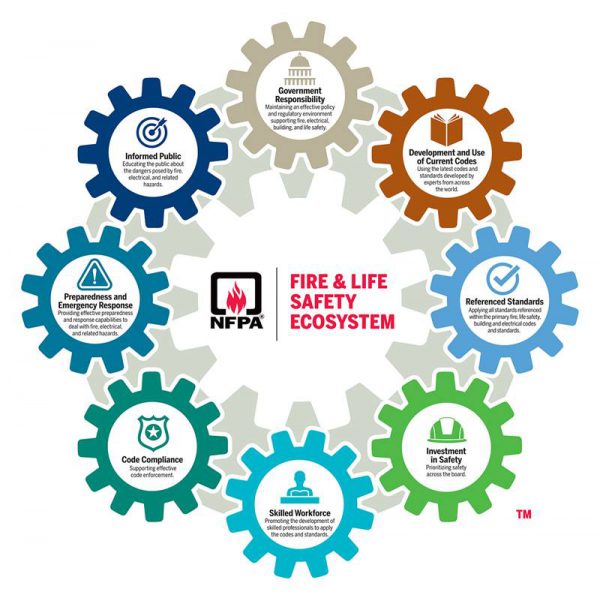 Image: NFPA Website The fire and life safety ecosystem led the discussion at the 2018 NFPA Conference and Expo. What is the fire and life safety ecosystem? Like any ecosystem, it is comprised of elements that work together to achieve a functioning system—in this case, eight separate elements that have to do with fire and safety. Several of them are the responsibility of the government, while many call upon the public to enforce and deliver. Regardless of who is charged with the responsibility, the goal throughout the ecosystem is to prevent major disasters from fire, electrical, and other hazards. When tragedies occur, it is likely there was a breakdown in one or more parts of the fire and life safety ecosystem. Here are the eight components relating to the fire and life safety code:
- Government Responsibility: Policy makers must maintain effective policy and regulatory environment and not prioritize politics over the public’s safety. When life safety codes are stripped for any reason, people’s lives are endangered for the sake of political gain.
- Development and Use of Current Codes: Government and building designers must implement the latest codes and standards or risk losing the latest technology and research in fire, electrical, life safety.
- Referenced Standards: All standards within the fire, life, building, safety, and electrical codes must be addressed or the right products and practices will not be used, possibly leading to disastrous results.
- Investment in Safety: Property managers and need to make an investment in safety to comply with the latest standards and codes. Hiring a company like Total Fire and Safety means an investment in safety. All the latest fire safety technologies are always available from TFS and we can design a program to fit any company’s needs and budget.
- Skilled Workforce: Promote the development of skilled professionals to apply the codes and standards. For over 20 years, TFS has employed highly skilled, highly trained, and highly dedicated workers in order to put customers’ safety above all else.
- Code Compliance: Effective code enforcement is necessary. Fire Marshalls and other officers must conduct regular inspections to ensure safety and code compliance.
- Preparedness and Emergency Response: Provide effective preparedness and emergency response capabilities to deal with fire, electrical, and related hazards. Train employees on emergency equipment, fire safety drills, designated leader in emergencies, etc.. TFS provides training classes for employees, as well as, informative literature on how to react in an emergency and much more.
- Informed Public: Educating the public is important, as is educating businesses about the specific fire hazards in their facilities.
No one cog in the fire and life safety ecosystem can keep us all safe from harm. Even all the pieces together, working in tandem, may not prevent every disaster, but they can certainly prevent many. By practicing and implementing the various areas outlined in the fire and life safety ecosystem, we can all create a safer community. At Total Fire and Safety, we are committed to helping you play your role in the fire and life safety ecosystem. Contact us today to discuss your fire safety needs or call 630-960-5060.
Category: Business Safety, Fire code violation, Fire Safety, Health and Safety, NFPA Compliance, Total Fire and Safety Tags: fire and safety equipment, fire and safety needs, fire and safety solutions, fire safety solution, fire safety training, Total Fire and Safety | Comments Off on What’s a Fire and Life Safety Ecosystem?
-
October 2, 2018 by Total Fire and Safety
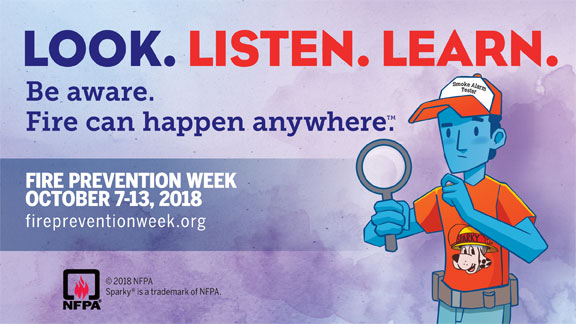
Fire prevention week was instituted in commemoration of the Great Chicago Fire of 1871 which burned from October 8-10, 1871 and took the lives of nearly 300 people. It burned nearly 3.3 square miles of Chicago and left over 100,000 residents homeless.
Forty years after the tragic blaze, the U.S. Fire Marshall used the anniversary to promote fire prevention and fire safety. In 1925, President Calvin Coolidge proclaimed fire prevention week as a national observance and it has become the longest running health observance in the country.
Even though we know more now about fire prevention than ever before and we have better equipment too, the National Fire Prevention Association (NFPA) released a shocking statistic: if you reported a fire in your home, you are more likely to die today than you were a few decades ago. Today’s home fires burn faster, allowing occupants less than two minutes to escape without harm.
Although the messages of Fire Prevention Week primarily focus on home fires, their messages can be applied at any location including businesses, warehouses, and other commercial spaces. Fire prevention week is a time to draw attention to the fire safety practices within your company using the resources provided by fire departments, the NFPA, and companies like Total Fire and Safety.
The following are some initiatives companies can take to observe Fire Prevention Week:
This year, fire prevention week runs October 7-13. The theme is Look. Listen. Learn. Be aware- Fire can happen anywhere. This year’s campaign focuses on basic but essential ways to escape your home fire safely with three simple steps:
- Look for places a fire could begin. Identify potential fire hazards in your workplace and remove them.
- Listen for the sound of the alarm. As soon as the alarm sounds, make your way out of the building at a safe distance from the fire.
- Learn two ways out of every room. Make sure all exits leading outside are free of clutter, unlocked and have emergency lights if necessary.
Fire prevention week is also commemorated at fire stations all over the area with special open houses and related programs. Here’s a roundup of some of the events in the Total Fire & Safety service area. For more information, see the website for each individual fire department.
If we can ever be of help to you during fire prevention week or any other time during the year, call Total Fire and Safety to ensure your business in in NFPA compliance with all of your commercial fire protection at 630-960-5060.
Saturday, Oct. 6
- Tinley Park Fire Department: 17355 68th Court, Tinley Park, 9 a.m. – 1 p.m.
- Schaumburg Fire Department: 950 W. Schaumburg Road, Schaumburg, 11 a.m. – 2p.m.
- Clarendon Hills Fire Department: 316 Park Ave., Clarendon Hills, 11 a.m. – 2 p.m.
- Minooka Fire Department: 7901 E. Minooka Road, Minooka, 11 a.m. – 2 p.m.
- Hazel Crest Fire Department: 2903 W. 175th St., Hazel Crest, 9 a.m. – 12 p.m.
- Bensenville Fire Protection District: 500 S. York Road, Bensenville, 12 – 3 p.m.
- Darien-Woodridge Fire Department: 7550 Lyman Ave., Darien, 10 a.m. – 1 p.m.
Sunday, Oct. 7
- Belvidere Fire Department: 123 S. State St., Belvidere, 1 – 4 p.m.
- Evanston Fire Department: 1817 Washington St., Evanston, 11 a.m. – 3 p.m.• West Chicago Fire Department: 200 Freemont St., West Chicago, 10 a.m. – 2 p.m.
- Cissna Park Fire Department: 206 N. 2nd St., Cissna Park, 11 a.m. – 5 p.m.
- Lake Zurich Fire Department: 321 S. Buesching Road, Lake Zurich, 11 a.m. – 2 p.m.
- Mokena Fire Department: 19853 S. Wolf Road, Mokena, 7:30 a.m. – 12 p.m.
- Peotone Fire Protection District: 7550 W. Joliet Road, Peotone, 11 a.m. – 3 p.m.
Monday, Oct. 8
- Western Springs Fire Department: 4353 Wolf Road, Western Springs, 6 – 8:30 p.m.
Wednesday, Oct. 10
- Downers Grove Fire Department: 6701 Main St., Downers Grove, 6:30 – 8:30 p.m.
Friday, Oct. 12
- Crete Fire Department: 524 W. Exchange St., Crete, 5 – 8 p.m.
- Beecher Fire Department: 711 Penfield St., Beecher, 5:30 – 8:30 p.m.
Saturday, Oct. 13
- Charles Fire Department: 112 N. Riverside Drive, St. Charles, 12 – 3 p.m.
- Harlem Roscoe Fire Protection District: 10544 Main St., Roscoe, 11 a.m. – 3 p.m.
- Schiller Park Fire Department: 9526 Irving Park Road, Schiller Park, 11 a.m. – 2 p.m.
- Northbrook Fire Department: 1840 Shermer Road, Northbrook, 9 a.m. – 12 p.m.
- Crystal Lake Fire Rescue Department: 100 W. Woodstock St., Crystal Lake, 11 a.m. – 2 p.m.
- Glen Ellyn Fire Department: 524 Pennsylvania Ave., Glen Ellyn, 10 a.m. – 1 p.m.
- Channahon Fire Department: 24929 Center St., Channahon, 11 a.m. – 2 p.m.
- Elk Grove Village Fire Department: 101 Biesterfield Road, Elk Grove Village, 12 – 3 p.m.
- Rolling Meadows Fire Department: 2455 Plum Grove Road, Rolling Meadows, 10 a.m. – 2 p.m.
- Lemont Fire Protection District: 15900 New Ave., Lemont, 11 a.m. – 2 p.m.
- River Forest Fire Department: 400 Park Ave., River Forest, 10 a.m. – 2 p.m.
- Northlake Fire Department: 118 E. Parkview Drive, Northlake, 12 – 3 p.m.
- Elgin Fire Department: 650 Big Timber Road, Elgin, 10 a.m. – 3 p.m.
- Prospect Heights Fire Protection District: 10 E. Camp McDonald Road, Prospect Heights, 10 a.m. – 2 p.m.
Sunday, Oct. 14
- Byron Fire Department: 123 N. Franklin St., Byron, 11 a.m. – 3 p.m.
- Manteno Fire Department: 13 S. Walnut St., Manteno, 12 – 3 p.m.
- Elmhurst Fire Department: 601 S. York St., Elmhurst, 12 – 4 p.m.
- North Palos Fire Protection District: 10629 S. Roberts Road, Palos Hills, 7 a.m. – 12 p.m.
- McHenry Township Fire Protection District: 3710 Johnsburg Road, Jonhsburg, 10 a.m. – 1 p.m.
Monday, Oct.15
Romeoville FPD Open House
Saturday, Oct. 20
- Dolton Fire Department: 14022 Park Ave., Dolton 10 a.m. – 3 p.m.
- La Grange Park Fire Department: 447 N. Catherine Ave., La Grange Park, 10 a.m. – 1 p.m.
- Hoffman Estates Fire Department: 225 Flagstaff Lane, Hoffman Estates, 1 – 4 p.m.
- Sycamore Fire Department: 2100 Frantum Road, Sycamore, 11 a.m. – 2 p.m.
Sunday, Oct. 21
- Grayslake Fire Department: 160 Hawley St., Grayslake, 7 a.m. – 12:30 p.m
Total Fire and Safety has a dedicated team of professionals that use the best technology to test and inspect fire safety equipment in any commercial building. TFS also provides training classes to educate employees both in the classroom and on-site. Knowledge is power and the more your employees know, the better they can protect themselves. What better time to spread the word than fire prevention week! If we can help you with your fire prevention in October or anytime, give Total Fire and Safety a call at 630-960-5060.
Category: Fire Extinguishers, Fire Extinguishers, Fire Safety, Sprinkler Systems, Total Fire and Safety Tags: fire and safety equipment, fire and safety needs, fire and safety solutions, Fire Extinguisher, lifesafety, Total Fire & Safety, Total Fire and Safety, training | Comments Off on Are Your Employees Ready for Fire Prevention Week?
-
May 30, 2018 by Total Fire and Safety
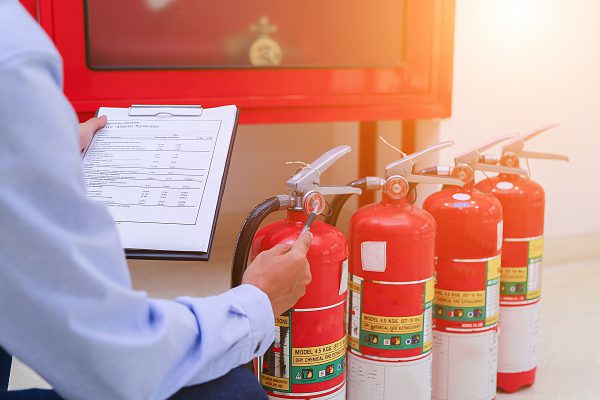
Most companies understand the mandate to have regular fire extinguisher inspections but many wonder why on earth a company could actually fail these inspections. After all, a fire extinguisher is rarely used so how can it need service?
Chances are you see a fire extinguisher every day, but how closely do you look at it? Even one dent in the tank can change the outcome. According to the NFPA, nearly 30 percent of fire extinguishers are not in proper working order. Total Fire and Safety’s twelve-point check can ensure your company’s compliance. However, there are five main reasons why companies fail a fire extinguisher inspection.
1. Unseen Damage– Corrosion or damage can occur over time in hard to see areas of the extinguisher, for example, rust within the tank. That is when a professional steps in and inspects the extinguisher inside and out. TFS will visually examine the extinguisher making sure it is free of dents, rust, or other hazards.
2. Potential Hose Blockage– Debris can clog the hose or deterioration of the O-rings can occur over time, rendering a fire extinguisher useless in an emergency. TFS will remove the hose completely to check for irregularities.
3. Possible Leaks– Whether large or small, a leak will cause the fire extinguisher to be inoperable. Anyone can check the pressure gauge to determine if there is a leak. However, if there is no pressure gauge, you will need a professional. TFS will confirm the compression in the tank.
4. Wear/Fading of Labels– Labels are vital when fighting a fire because they contain instructions on how to use the extinguisher. They also provide important information about the device’s maintenance history, which is needed by inspection professionals. Once your fire extinguisher inspection is complete, the labels will be updated, and an additional certification tag will be attached.
5. Recharging Needed– Once a fire extinguisher is used, even partially, it will need to be recharged immediately. If you fail to recharge the extinguisher, it will fail you in a fire.
Although these are common reasons companies fail fire extinguisher inspections, there are other possible hazards not listed. It is important to stay up-to-date with your fire extinguisher inspections. The NFPA requires inspection every month and maintenance every year by a professional. In addition, a stored pressure extinguisher requires internal maintenance every six years and a hydrostatic test every 12 years.
It takes a minute for a fire to spread and cause irreparable damage to your company—the same amount of time it takes to schedule a fire extinguisher inspection!
Total Fire and Safety can inspect your fire extinguishers to ensure they are unfailingly ready to fight fire at a moment’s notice. We also provide onsite training for your employees, including hands-on practice in the use of a fire extinguisher. Give us a call today at 630.960.5060.
Category: Business Safety, Fire code violation, Fire Equipment Inspections, Fire Extinguishers, Fire Extinguishers, Fire Safety, NFPA Compliance, Total Fire and Safety Tags: equipment, Extinguisher, fire and safety equipment, fire and safety needs, Fire Extinguisher, fire extinguisher inspections, fire safety, safety, Total Fire & Safety, Total Fire and Safety | Comments Off on Why Companies Fail Fire Extinguisher Inspections
-
March 21, 2018 by admin
Join us for the 2018 Fire Safety Symposium
at Total Fire & Safety!
Register below! Space is limited!
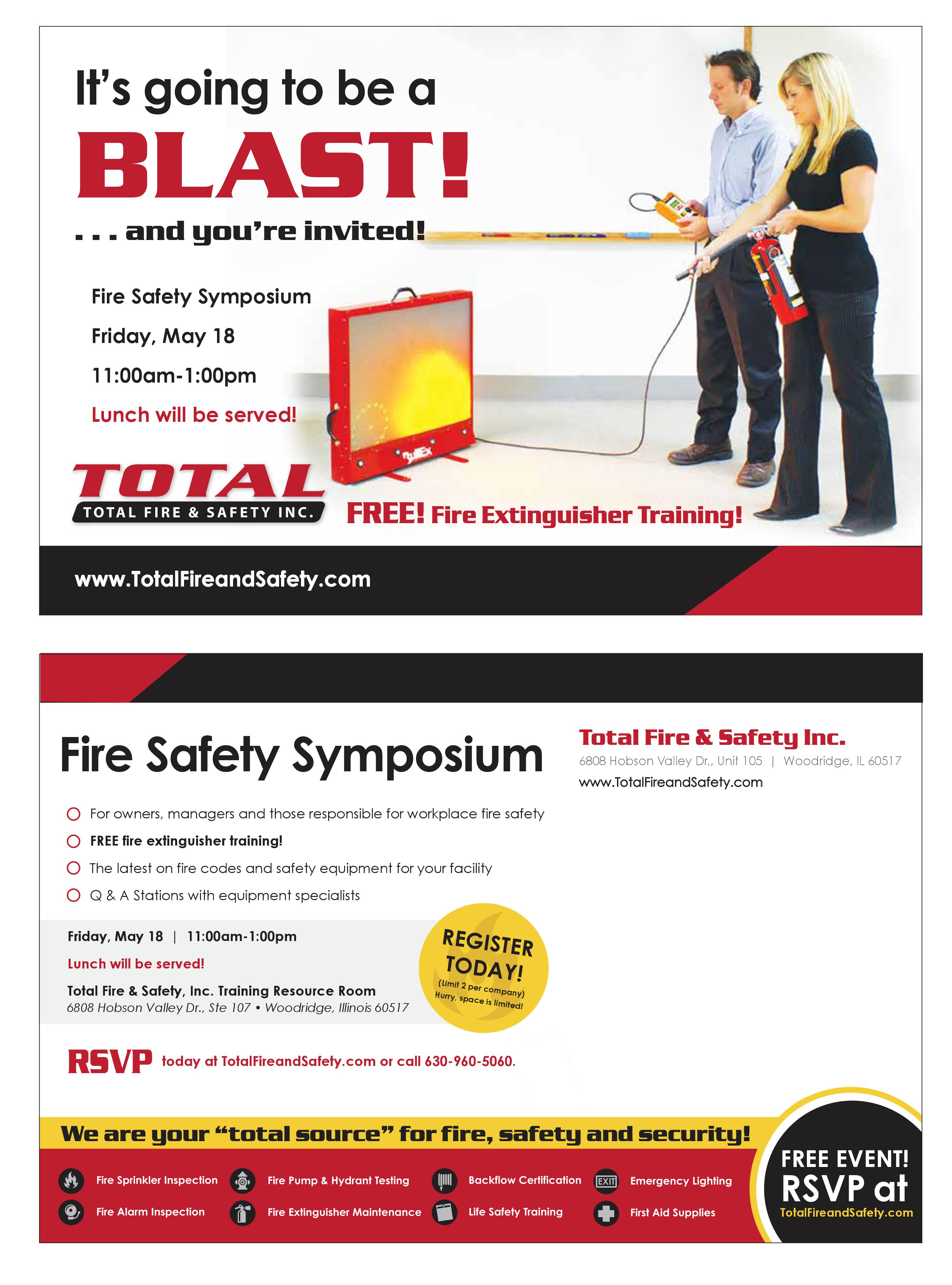
Category: Business Safety, Client Events, Fire Extinguishers, Fire Extinguishers, Fire News, Fire Safety Tags: commercial fire safety, employee training, fire and safety equipment, fire and safety solutions, Fire Extinguisher, fire safety, fireextinguisher, Fireextinguishertraining, Total Fire & Safety, Total Fire and Safety, training | Comments Off on Fire Safety Symposium
-
February 14, 2017 by Total Fire and Safety

If you visit the TFS headquarters in Woodridge, Illinois, make sure you take a look at our newly remodeled training room. Training is essential to what we do at Total Fire & Safety, not only for new employees but to help existing ones stay up-to-date on the latest hazards, fire codes and prevention techniques.
Our existing employees know the training room well. This is a picture of our fire extinguisher division meeting. Every month, each division of Total Fire & Safety, fire extinguisher, sprinkler, fire alarm and backflow, meet for monthly training and information exchange sessions. By gathering together, our team in each division can share information about their experiences in the field and discuss what is working or needs to be improved. Each division has their own concern with fire safety, so holding these division exclusive meetings is very helpful.
Who benefits most from these meetings? The TFS customer!
These meetings are one of many ways TFS is always trying to become more efficient and stay abreast of the latest in fire prevention and NFPA codes for their customers. The meetings help Total Fire & Safety deliver their very best in expertise, installation, maintenance and customer service to all our wonderful customers.
Thank you to all of our customers for making 2016 a great year for us. We promise to do everything we can as your commercial fire protection company to make 2017 a safe one for your commercial fire safety. If you have any questions about fire safety for your business or want to update your fire equipment going into the new year, don’t hesitate to contact us at 630-960-5060.
Category: Fire Safety, Total Fire and Safety Tags: fire professional training, fire safety training, fire training, Total Fire and Safety, total fire training | Comments Off on A New Year in TFS’s Commercial Fire Protection Training Room
|

|
|
|
|
|
|

 Facebook
Facebook
 Instagram
Instagram
 LinkedIn
LinkedIn











